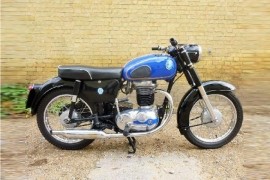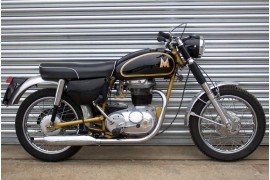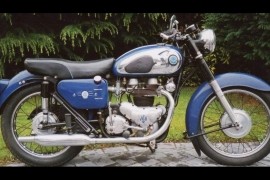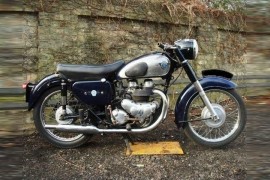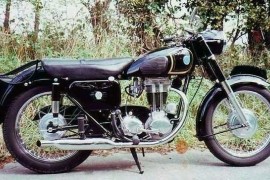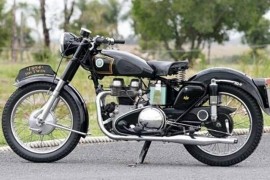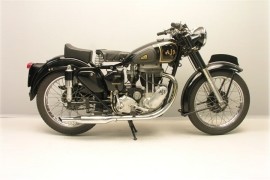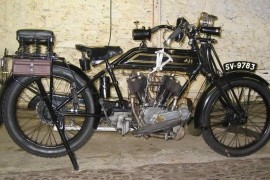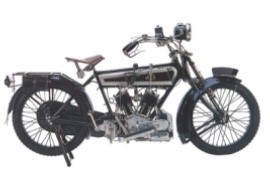AJS Model Models/Series Timeline, Specifications & Photos
First production year: 1912
The 1960 AJS Model 8 350 has, at its heart, an air-cooled, four-stroke, 347cc, single cylinder powerplant mated to a four-speed manual transmission, and can produce a claimed 21 horsepower at 6250 rpm. It also boasts standard features such as laced wheels, full fenders, a dual seat, a single, chromed exhaust system, a large headlight, a cartridge fork as a front suspension coupled to dual rear shocks, a drum braking system, a 12-liter (3.3-gallon) fuel tank, and mid-mounted foot pegs.
The 1958 AJS Model 14 250 sports an air-cooled, four-stroke, 248cc, single cylinder powerplant paired to a four-speed manual transmission. This classic machine also came standard with features such as a dual seat, a single, chromed, exhaust system, laced wheels, dual shocks as a rear suspension, a telescopic front fork, a drum braking system, and a large, 18-liter (4.8-gallon) fuel tank.
The 1957 AJS Model 31 650 has, at its heart, an air-cooled, four-stroke, 646cc, parallel twin powerhouse paired to a four-speed manual transmission, and can reach a maximum power output of 43 horsepower at 6000 rpm.
It comes standard with features such as a blacked-out frame, a suspension package composed of a front telescopic fork and dual shocks as a rear suspension, a dual seat, a chromed, dual exhaust system, laced wheels, full fenders, and a dual tone paint scheme.
The 1956 AJS Model 30 600 is a powerful classic two-wheeler, that has been created for the adrenaline-junkies among AJS fans. It sports an air-cooled, four-stroke, 593cc, parallel twin cylinder engine mated to a four-speed manual transmission, and can produce a claimed 33 horsepower at 6800 rpm.
It comes standard with features such as a laced wheels, a dual seat, a dual, chromed, exhaust system, a large headlight, a center stand, full fenders, a suspension package composed of a front telescopic fork and dual shocks in the rear, a drum braking system, a large headlight and a blacked-out frame.
The 1950 AJS Model 16 350 is a classic machine that has, at its heart, an air-cooled, four-stroke, 347cc, single cylinder powerhouse paired to a four-speed manual transmission, and can reach a maximum power output of 18 horsepower at 5750 rpm.
Standard features include laced wheels, a dual seat, a blacked-out frame, a front telescopic fork coupled to dual shocks in the rear, a drum braking system, a 13-liter (3.6-gallon) fuel tank, a large headlight, full fenders, a center stand and mid-mounted foot pegs.
The 1948 AJS Model 20 500 has, at its heart, an air-cooled, four-stroke, 498cc, parallel twin cylinder powerplant mated to a four-speed manual transmission. It comes standard with features such as laced wheels, a suspension package composed of a front telescopic fork and dual rear shocks, a solo, sprung seat, wide handlebars, an analogue instrument cluster, a dual exhaust system, full-fenders, a blacked-out frame, and a large, 17-liter (4.5-gallon) fuel tank.
The 1945 AJS Model 18 500 has, at its heart, an air-cooled, four-stroke, 498cc, single cylinder powerhouse paired to a four-speed manual transmission, and can reach a maximum power output of 28 horsepower at 5600 rpm.
This classic two-wheeler was addressed for a wide variety of riders, and came standard with features such as laced wheels, a telescopic front fork, dual shocks as a rear suspension, a drum braking system, a two-piece, dual seat with a sprung rider seat, a 13-liter (4.2-gallon) fuel tank and a chromed exhaust system.
The 1925 AJS Model E1 is one of the first V-twin motorcycles produced by the British brand, and was defined by features such as a hardtail rear suspension, a sprung rider seat and a sprung passenger seat, pull-back handlebars, laced wheels, a rigid front suspension, and a small headlight. At its heart lies an air-cooled, four-stroke, 799cc, V-Twin powerplant paired to a three-speed manual transmission, and can produce a claimed 8 horsepower.
The model D, with a displacement of 698cc, first appeared in 1912, being the first from the AJS big twins line that ended with a huge machine of 1000cc, manufactured in 1930. This bike was equipped with all-chain drive and a three speed gearbox. The first engines had detachable cylinder heads but in 1913 integral heads were introduced because there were complaints of some leakage. In three years, the capacity of the machine increased to 748cc.
